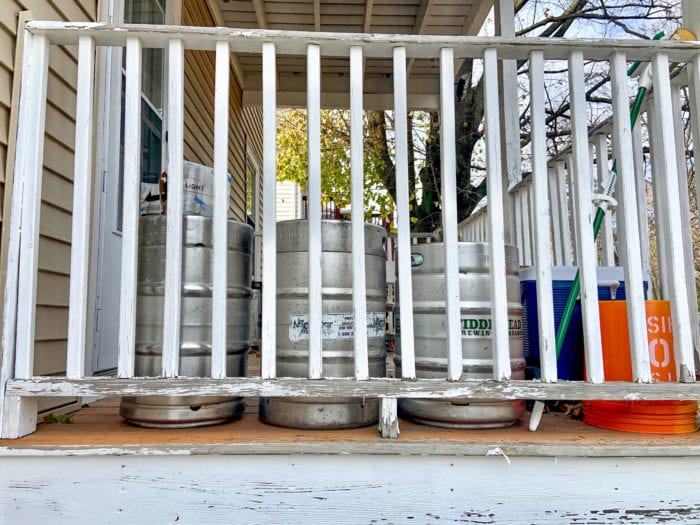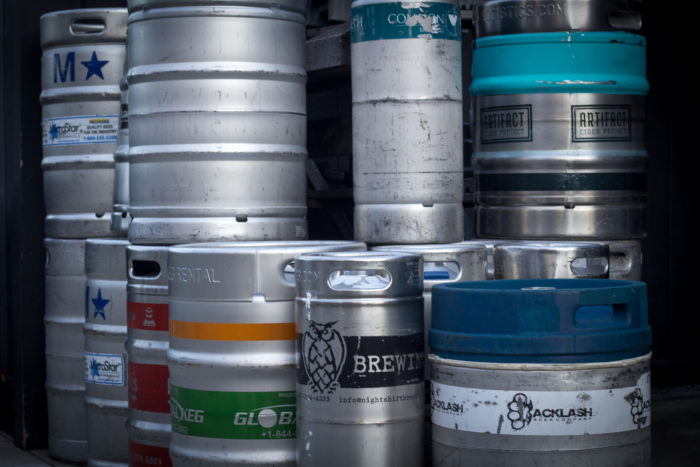
“We are built to sell a lot of kegs, not a little.”
Large social gatherings are out of question. This certainly includes but is not limited to keggers, which ostensibly feature a keg of draught beer meant to be shared among attendees.
With more lockdown measures and holidays ahead, why not have a solo party? To paraphrase the musician and motivational speaker Andrew W.K., a pizza for one still counts as a pizza party.
A keg (half barrel), though, is a lot of beer. Like, 124 16-ounce pints “a lot.” Beer is normally kegged in two formats, half barrels and one-sixth barrels, also called “sixtels” or “logs” given their shape. As breweries move toward more direct-to-consumer sales, those with home draft systems may have greater access to a larger volume of beer. However, kegs at home are not going to be what saves draught beer.
In the initial wave of temporary restaurant closures during the earlier phases of the pandemic, many wholesalers attempted to sell kegs as fast as possible. This was a time where the public had the opportunity to get beers that were normally not as accessible for retail.
Tarah Maresh of the Mass-based Modern Draught has noticed more inquiries for home draft systems. She advises, “The basic pre-built kegerator is going to come with low quality components, with any metal typically made of brass. Brass will corrode over time and contribute to some really funky build up. Stainless steel should be the standard for all draft equipment, especially in home systems that might not get regular maintenance.” Maresh is currently working on her own build and remodel of a kegerator from a vintage fridge frame. She urges, “If someone is looking to really properly serve their beer, make sure to go stainless steel everything, look for faucets with flow controls for high pressure products, check temperature recommendations for beer types, and keep those lines clean.”
Beer, like any food, is a perishable product. Maresh thinks that is good to keep in mind, since “partial kegs will go flat, IPAs will lose their bite and freshness, and the beer [sitting] in the line [can create] build up.”
Joe Connolly, director of Springdale Beer, says, “I don’t think people want to sit on a keg and have one beer over time,” observing mixed four-packs of 16-ounce cans growing in popularity.
Those who purchased kegs in a pre-COVID time are questioning their buying habits now. Simay Kinawy, resident of Brighton and former beertender, agrees with Connolly and says, “I used to purchase a lot of kegs. Half barrels of [macro lager] when I threw parties, but I was also content on having a few logs in the fridge. I haven’t purchased a keg recently. For homesale, it’s never really been a keg buyers market. It’s not really appealing to sit with the same beer over a long period of time.”
Connolly continues, “We are not heading towards a great home draft revolution, as much as we all miss draft beer. I am certainly one who does. Fresh draft beer is great, but I don’t think most home systems are built for that. And we are not really built to fill that need as breweries, we are built to sell a lot of kegs, not a little.”
Depending on the size of a brewery and its service model, the more it will keg vs. package. Since COVID-19 has shuttered many restaurants and bars, limiting drinking draft beer, kegging and keg sales have significantly gone down. Mike Dyer, Director of Marketing at Trillium Brewing, says “With closure of its taprooms for the winter months, Trillium is directing its production solely into cans and bottles for to-go and home delivery orders.”
The shift to a canned package format is more sensible for a number of reasons. One of which being that for larger breweries, especially those that distribute out of state, it’s only practical to operate and staff the process when kegging over 20 barrels (40 kegs). Joe Connolly, director of Springdale Beer, shares data from the month of November year-over-year packaging: About one-sixth of half barrels and one-quarter of the sixtels have been kegged compared to November 2019.

Bone Up Brewing Co. in Everett operates out of a 3.5-barrel brewhouse system that was intended to service a taproom on a 100% draft model, supplemented with growler and crowler to-go sales. Liz Kiraly, brewer and co-owner, says, “Before this year, we were packaging 90% of our beer in kegs and the other 10% in 500mL bottles—our barrel aged and funky, wild stuff. At the beginning of this year, we were researching proper canning options, mobile canning, contract brewing, in house canning line, et cetera, with the intent to ramp up brewing operations and keg 60% for taproom sales and can 40% for distribution.”
By February, Bone Up ended up using a mobile canning company to test the waters. In October, the team crunched the numbers and purchased their own canning line for packaging. Kiraly explains how pivoting so frequently and seasonally influenced decisions to keg less beer, but says that Bone Up does offer kegs to-go. “If a customer requests a keg from us, we usually get it to them through Craft Beer Cellar or Kappy’s but we’d absolutely be open to selling directly.”
Other direct to consumer keg sales have continued. On Dec 7, the Allagash Brewing tasting room posted a photo on social media teasing its packaging formats available from the brewery. “You can get Allagash White in a 12oz bottle, a 12oz can, a 16oz can, a 18.2oz can, and a 661oz can. Actually, we call that last one a keg,” the post describes, and encourages a follow-up on its blog entry on “How To Tap A Keg.”
Boston operations can perhaps learn from other cities. In Chicago, Dovetail Brewery has been raffling kegs for charitable benefits. Jenny Pfäfflin, brewer and social media manager of Dovetail, tweeted, “Lager is our ‘house beer’ and it’s only available draft-only to bars and restaurants on purpose; those are our homes, too. We can’t sell a lot of Lager rn due to shutdowns, so we’re offering kegs to take home, with proceeds benefiting the Chicago Restaurant Workers Relief Fund.”
Samer Khudairi is a freelance journalist who covers design, music, action sports, and craft beer. His name means the person who tells stories at night. Samer abides by the mantra, 'live all the lives. love all the peoples.'

